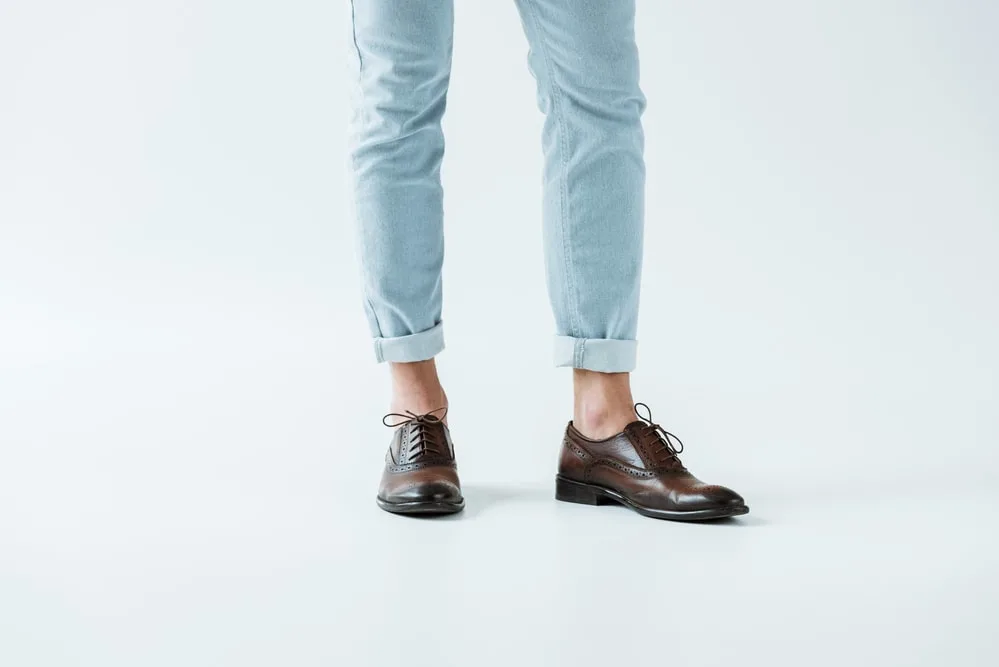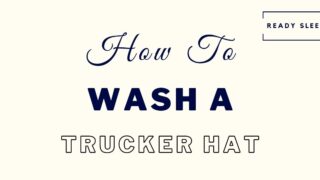Shoes that don’t fit could ruin anyone’s day. The trouble is, it doesn’t always become obvious until you’ve tried them on for a while. The question is, can you return shoes after wearing them?
Most stores will allow you to return worn shoes, as long as it’s done so within a specific timeframe and there are no signs of visible damage. Some stores, usually small and independent ones, may refuse the return of any worn shoes, regardless of their condition.
Although that’s the short answer, there’s more to it.
Let’s talk through exactly what you need to consider before trying to return shoes that have been worn.

How To Know If You Can Return Worn Shoes (3 Factors)
If after going through these factors you feel as though you really can’t return those worn shoes, you’ve potentially saved yourself from wasting your time.
If, however, you feel as though you can – then go for it.
1. Store Return Policy
This is by far the most important factor.
The store you bought the shoes from will usually have a pretty specific returns policy for certain items in particular (such as shoes), or for all items in general.
The returns policy for shoes will usually fall into one of the following categories:
- They can be returned in any condition within a certain period of time
- They can be returned within a certain period of time, as long as there are no visible signs of damage
- They can be returned only if they’ve been worn indoors, not outdoors
- They cannot in any way be returned once they’ve been worn
Let’s talk through them, one by one.
Returned In Any Condition Within A Period Of Time
You will find certain stores that would accept the return of worn shoes, as long as they’re returned within a certain period of time.
They offer a sort of “trial period” for the shoes so that they can be worn to your desire, knowing that you can return them if you eventually find they aren’t the right ones for you.
It’s usually larger brands and corporations that can afford to offer this sort of policy.
For example, at the time of writing this, Nike has a 60-day return policy where you’d be able to return your shoes regardless of how much you’ve worn them, as long as you do so within this timeframe.
While it’s a massive trust signal for the buyer, as you’d expect, it’s easy to take advantage of.
There will be people abusing the policy and buying shoes with the intention of returning them a month later.
Returned Within A Certain Period With No Signs Of Damage
As with most returns policies, this one is also time-sensitive. The shoes need to be returned within a certain time period.
However, they also need to be returned with no visible signs of damage.
It works on the assumption that shoes with no signs of damage would still have some sort of resale value.
Returned If Worn Indoors But Not Outdoors
This one is even more specific.
These stores would still almost always have a specific time within which you need to return them. They would also usually say that they should be returned in the “same condition”, which means there shouldn’t be any visible damage to the shoes.
However, they go a step further by saying that they cannot be worn outdoors.
It makes sense because shoes worn outdoors are a lot more likely to get stained, scuffed, scratched, and pick up all that grime off of the street.
However, it doesn’t really give the wearer a real “trial” of the shoes, because there’s only so much walking you can do indoors. Walking around a mall might be a pretty good solution, however.
But the bottom line here is that it’s important to be fully aware of this returns policy before you buy the shoes.
Cannot Be Returned Once Worn
In many ways, this is the most simple returns policy to interpret, but by far the strictest.
These stores simply won’t accept shoes once they’ve been worn because ultimately, they won’t be able to resell them at full value.
They’d be making a loss on the product and would expect you to be happy with the shoes you bought before buying them.
It’s a tough one. While many feel this is fair, others say that it’s simply not possible to know whether a pair of shoes is the right fit until they’ve been worn out in the world.
Taking a few steps in a department store isn’t the best way of knowing when a (potentially pretty expensive) is actually comfortable or not.
But almost all returns policies will have a specific provision where they can be returned if the product is defective.
Let’s talk about that now.
2. Damage Vs Defect
Retailers are usually required to provide a full refund if the product is genuinely defective and not just damaged due to wear and tear.
If a shoe has a defective construction, you’ve got a good chance of getting a refund.
However, even with this provision, there is usually a timeframe within which the defective product needs to be returned.
Trying to return a “defective” product a whole year after you bought it is going to be much trickier than trying to do so the week after.
Defective shoes may fall apart after a single use – in these instances, it’s easy to see why a full refund should be given.
3. Guilt And Intention
Unfortunately, there are plenty of people that take advantage of return policies. They buy them with the sole intention of wearing them and then returning them a short while after.
They know how to play the game.
Ultimately, this is unethical no matter how you look at it, no matter how “big” the corporation or store may be.
At the end of the day, the store will make a loss on the item that’s essentially been “borrowed”. There’s no way it can be resold at full value afterward.
While this factor doesn’t have anything to do with store policy, it’s still important.
Consider your intentions before making the decision.
How To Return Worn Shoes (If You Can)
If you’ve considered the factors above and feel as though you’d be entitled to a refund if you were to return them, use the following tips to do it in the right way.
1. Always Keep The Receipt
Keeping the receipt will make things a lot easier when trying to return your shoes. All it does is act as proof of purchase.
Solid evidence that you actually bought the shoes from that particular store.
While many stores will accept a bank statement as proof, some may only allow for store credit and not a cash refund if you don’t have a receipt.
It really just depends on the store.
So, always keep the receipt. In addition, keep the tag on too. It isn’t essential, but it just means your returns process will have a little less friction.
The more those shoes look new, the more likely it is you’ll get a refund.
2. Take Photographs
This is especially important if your shoes are defective.
Defective shoes will usually be entitled to a full refund once returned. However, you’ll want to take pretty detailed photographs of the defect itself for your records.
Take them from different angles. A video taken on a smartphone may also be helpful, depending on what the defect actually is.
3. Don’t Want Too Long
The main reason for this is that you’ll want to stick to the timeframe the return policy specifies.
They usually will give you a timeframe.
But even within this timeframe, you’ll usually find that the sooner you return them, the less friction you’ll have when trying to do so.
Let’s say you’ve got a 60-day returns policy.
Returning those shoes on day 6 is going to be a lot easier than trying to do so on day 56.
For one, after 56 days of use, there’s likely to be signs of visible damage, which will make returning them much more difficult with most stores.
In addition, on day 56, the store will probably take a closer look at those shoes or look for reasons why it isn’t possible, despite it technically being within 60 days.
Remember, returns policies will usually always have the small print you may have missed. The longer you wait to return them, the more likely it is that the store will look for exceptions in the policy.
4. Be Respectful
Remember, the cashier does not set the rules. If you try and fail to return a pair of shoes and the cashier politely tells you exactly why, be respectful.
If they simply quote their returns policy and it’s clear that the shoes you’re trying to return cannot be returned, simply accept it and walk away.
Frequently Asked Questions
Here are some frequently asked questions on returning worn shoes to really round off this topic.
Can You Return Shoes After Wearing Them Once?
Shoes that have been worn once may still be refused a refund because the number of times they’ve been worn usually doesn’t matter. The time since purchase and whether there are signs of visible damage are both usually more important than the number of times they’ve been worn.
Let’s use some examples.
A store’s returns policy may say that you can return them in any condition, as long as it’s within 60 days of purchase.
If you wear them once, but on day 65, you won’t be able to return them.
Let’s take a store that says you can return them within a certain timeframe, as long as they’ve not been worn outdoors.
You won’t be able to return those shoes if the one time you wore them happens to be outdoors.
So, the number of times you wear them usually makes no difference to whether you can return them or not. It all depends on the store’s returns policy.
Can You Return Running Shoes After Wearing Them?
You may be able to return running shoes if the store allows you to return worn shoes within a certain timeframe. They’ll usually specify that there should be no signs of visible damage, although larger corporations do sometimes accept returns in any condition within the specified timeframe.
Running shoes are, in many ways, difficult to return with most stores.
The reason for this is that you’ll usually be wearing them outdoors and also subjecting the shoes to quite a lot of wear and tear.
Returning them with no signs of damage is extremely difficult.
Because of this, you’re most likely to be able to return the running shoes if the store or brand allows you to return them no matter what condition they’re in.
It’s usually the larger brands that can afford to do this, but they will usually require that they’re returned within a certain time window (30 days or 60 days after purchase).
Conclusion
Hopefully, you should now have a much better idea of whether you can return your worn shoes.
As you can see, there are a few different factors to consider, but it’ll usually come down to the specific store’s policy.
Ready Sleek founder. Obsessed with casual style and the minimalist approach to building a highly functional wardrobe. Also a fan of classic, vintage hairstyles.

![Can You Return Shoes After Wearing Them? [Solved]](https://www.readysleek.com/wp-content/uploads/2021/12/Can-you-return-shoes-after-wearing-them-720x405.jpeg)





